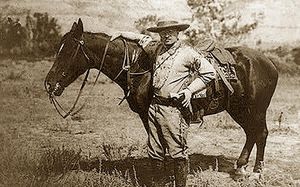Theodren Cúchulainn
Sir Theodren Cúchulainn Esq. | |
|---|---|
 | |
| Born | January 12, 1848 |
| Died | August 3, 1933 (aged 85) |
| Cause of death | Old age |
| Resting place | Cúchulainn Family Cemetary, Cúchulainn Estate, Killarney, Paleocacher |
| Monuments | Theodren Cúchulainn Memorial, Gardena, Paleocacher |
| Nationality | Paleocacherian |
| Citizenship | Paleocacherian |
| Education | PhD |
| Alma mater | National University of Paleocacher, Bullmar Campus, Paleocacherian Military Academy |
| Occupation | Explorer, Conservationist, Politician, Army Officer |
| Organization | Paleocacherian Geographic Society |
| Known for | First Person to climb Mount Coomlaughra, First person to visit both poles, Founded Paleocacherian National Parks Service |
Notable work | "By Sea, Air and Land; Journeying to Both Poles and Discovering New Lands." |
| Height | 6 ft 2 in (188 cm) |
| Title | Secretary of the Interior |
| Term | 1905-1916 |
| Political party | National Union Party |
| Spouse(s) | Eloise Cúchulainn |
| Children | 8 |
Sir Theodren Cúchulainn was a famous Paleocacherian explorer of the 19th and early 20th centuries. He was born to a wealthy landowning farm family in Donegal in 1848. He was the first person to climb Paleocacher's tallest peak Mount Coomloughra at the age of eighteen as a part of an expedition mounted by his fraternity at the National University of Paleocacher's Bullmar Campus. The expedition tried several different routes before Cúchulainn found a free climbing route up a sheer two hundred foot face and reached the summit. As a result of this feat, he was knighted by King Brian III in 1866. He spent most of the next three years in school and on Paleocacher's frontiers, especially in the Fjordland charting remote waterways and mountain passes. In 1869 he went to the Paleocacherian Military Academy and he graduated in 1872. He served in the Army Scouts for a decade and a half before being discharged to the reserves at the rank of Lieutenant Colonel in 1887. He co-founded the Paleocacherian Geographic Society in 1889. From 1889 to 1903 he lead several expeditions to remote parts of the world including explorations of Lyoan and Karimunese rainforests. He also developed an appetite for big game hunting and discovered almost two dozen species of mammals and reptiles unknown to science. In 1903 after hearing of a planned Quebecshirite expedition to the North Pole, he commissioned an expedition from the Geographic Society. He and his team successfully visited both the North and South Poles over the next sixteen months. In 1905 he was chosen by the president to head the new Paleocacherian Department of the Interior to manage the nation's natural resources. In his eleven years in this position he created the first national parks and refuges, set up regulations for the conservation of natural resources and advocated for progressive politics. He was elected as a Representative from Donegal in 1916 and spent six years in the National Assembly, two of them as Speaker of the Chamber of Generals. He retired from politics in 1920. He conducted another expedition to the South Pole in 1922 where his expedition team circumnavigated the continent, mapped most of its coastlines and discovered an island which he named Culdee for its high peaks of ice. He flew in an airplane over the pole and back again. After this expedition he retired to his home and spent the last decade of his life writing and spending time with his family. He died in 1933 at the ripe old age of 85.